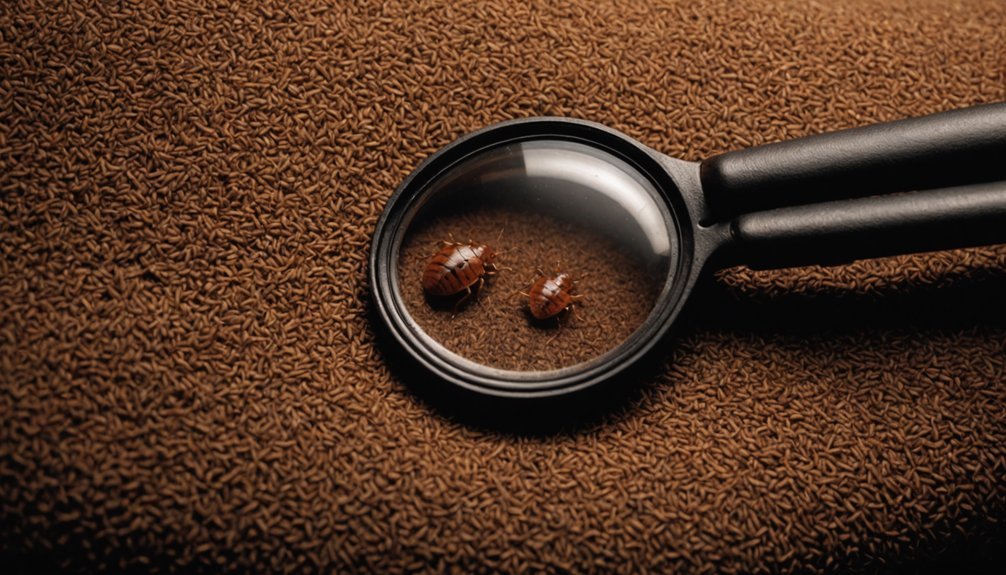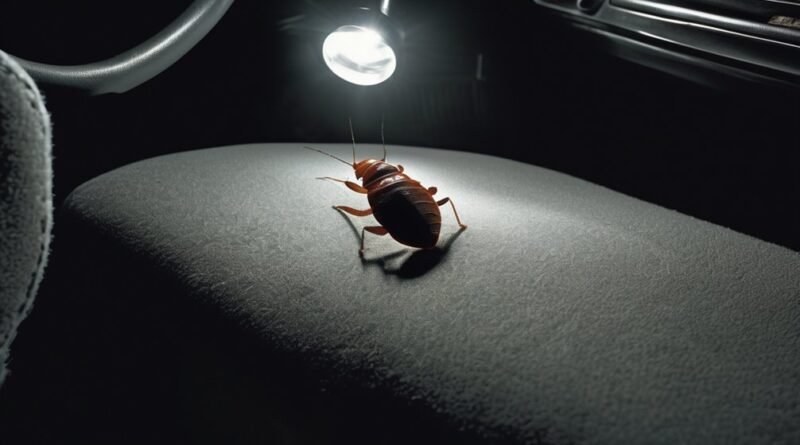Do Bed Bugs Live in Cars? How to Inspect & Treat
If you’ve spotted a suspicious bug in your car or you’re worried about bringing bed bugs home from a recent trip, you’re right to be concerned. These resilient pests can indeed survive in vehicles, turning your daily commute into an uncomfortable experience. While cars aren’t their preferred habitat, bed bugs will adapt to any space that offers access to human hosts. Let’s explore how to identify, inspect, and eliminate these unwanted passengers.
Key Takeaways
- Bed bugs can survive in cars for 2-3 months without feeding, preferring to hide in seat fabrics, crevices, and floor mats.
- Look for reddish-brown stains, dark fecal spots, shed exoskeletons, and a musty odor as signs of infestation.
- Inspect thoroughly using a bright flashlight, focusing on seat seams, upholstery folds, and carpet edges during daylight hours.
- Treatment options include Nuvan strips, chemical sprays, steam cleaning above 119°F, and parking in direct sunlight.
- Maintain protection through regular vacuuming, professional inspections, and storing luggage in sealed containers when traveling.
Can Bed Bugs Actually Survive in Cars?

While bed bugs prefer living in homes near regular human hosts, they can indeed survive in vehicles under the right conditions.
These resilient pests can endure temperatures between 46°F and 117°F, making car interiors viable temporary habitats during moderate weather.
Bed bugs thrive in temperatures from 46°F to 117°F, allowing them to temporarily survive in parked vehicles during mild seasons.
You’ll find that bed bugs can survive without feeding for 2-3 months, with some adults lasting up to a year.
They’ll hide in your car’s crevices, seat fabrics, and floor mats while waiting for their next blood meal.
However, cars aren’t ideal long-term homes for these insects.
The lack of stable hiding spots, frequent temperature fluctuations, and inconsistent access to human hosts make vehicles less suitable than residential environments. Look for signs of infestation like dark fecal spots clustered on surfaces.
Still, your car can serve as an effective transport vessel, allowing bed bugs to hitchhike between locations.
Common Signs Your Car Has Bed Bugs

Knowing that bed bugs can survive in your car makes it essential to spot the warning signs early. Look for reddish-brown stains on seats and mats, along with dark fecal spots that resemble ink splatters in fabric seams.
You’ll often find shed exoskeletons and pearly white eggs hidden in cracks and beneath cushions. A musty, sweetish odor similar to spoiled coriander may indicate a large infestation, especially in enclosed areas like glove compartments and under seats.
Watch for small, brownish, oval-shaped bugs in fabric folds and seams, though they’re most active at night. Using double-sided sticky tape can help catch bed bugs in hard-to-reach areas where you might find discarded shells and droppings.
Unexplained bites after sitting in your car could also signal an infestation.
How Bed Bugs Get Into Your Vehicle

Although bed bugs prefer living in homes and hotels, they’re surprisingly adept at infiltrating vehicles through various means.
These pests commonly hitch rides on your clothing, bags, and personal belongings, especially if you’ve been in infested areas.
Your travel habits greatly impact the risk of car infestation. When you store luggage in your vehicle after staying at hotels or using public transportation, bed bugs can easily transfer from your bags into your car’s upholstery and crevices. Those who drive for rideshare services face heightened exposure to potential bed bug problems.
They’re particularly fond of hiding in seams and fabric folds.
Regular exposure to infested locations increases your chances of carrying bed bugs into your vehicle. This includes parking near infested buildings, moving between contaminated homes, or frequently transporting items from uncertain sources without proper inspection.
Where to Look for Bed Bugs in Cars
Bed bugs in vehicles can hide in numerous spots, making thorough inspection challenging but necessary.
You’ll need to check seat seams, folds, and the underside of seats carefully, as these are prime hiding spots. Don’t forget to examine between cushions and headrests where bugs often nest.
Pay special attention to carpet edges where they meet the car’s frame, and lift floor mats to inspect underneath. The bugs’ remarkable hitchhiking abilities enable them to move easily between these areas undetected.
Check cracks in plastic components, dashboard assemblies, and areas where upholstery meets hard surfaces. The trunk deserves thorough inspection, particularly beneath liners and in spare tire wells.
Look closely at seat belt mechanisms, especially where buckles meet fabric.
Use a bright flashlight to examine all fabric elements, including headliners, soundproofing materials, and interior handles where bugs might seek shelter.
Essential Steps to Inspect Your Car
You’ll need a bright flashlight and double-sided tape to spot the telltale signs of bed bugs, including shed skins, black fecal spots, and live bugs in your car’s tight spaces.
Start your inspection by removing all clutter and checking the most common hiding spots like seat seams, floor mats, and trunk edges where bed bugs often congregate. A close inspection of your vehicle is crucial since young bed bugs are smaller and harder to detect.
The best time to inspect your car is during daylight hours when you can combine natural light with your flashlight to thoroughly examine every crack and crevice.
Visual Signs and Tools
When searching for bed bugs in your car, proper visual inspection combined with the right tools can make all the difference in detecting an infestation early.
Look for dark stains on upholstery, tiny pale yellow shed skins in seams, and small brownish oval-shaped insects hiding in crevices.
You’ll need a bright flashlight to illuminate dark spots, a magnifying glass to spot eggs and small bugs, and a vacuum with a crevice tool to extract them.
Focus your inspection on seat seams, removable covers, seat belts, floor mats, and door panels.
Don’t forget to check the trunk edges and dashboard cracks.
Watch for signs like blood spots, translucent shells, white egg clusters, and live bugs.
If you notice a musty, sweet odor like overripe raspberries, it might indicate a severe infestation.
Where to Look First
To effectively inspect your car for bed bugs, start with the areas where these pests most commonly hide and breed.
Begin with the seats, paying close attention to seams, cracks, and the spaces between cushions. Check under and around the seats, focusing on the tracks and mounting hardware where bugs often shelter.
Move on to inspect the upholstery folds, stitching, and any removable seat covers.
Don’t forget to examine the glove compartment, storage consoles, and door panels, as these dark, undisturbed spaces make perfect hiding spots.
Look beneath floor mats and along carpet edges where bed bugs can easily conceal themselves.
Be thorough when checking the sun visors and dashboard area, as these areas provide additional shelter when bugs aren’t actively feeding.
Timing Your Inspection Right
Proper timing can make the difference between detecting bed bugs and missing them entirely.
You’ll have the best chance of spotting these pests during early morning or late evening when natural light is low. Use a flashlight during these times to examine seams and crevices more effectively.
Schedule your inspection when the car’s temperature is between 46°F and 113°F, as bed bugs are most active in this range.
If you suspect exposure, inspect your car immediately and follow up 7-10 days later to check for new signs like fresh excrement or shed skins. Remove all items and vacuum thoroughly before inspecting.
For high-risk situations, such as frequent passenger transport or travel to infested areas, conduct weekly inspections and place monitoring traps under seats between checks.
Treatment Options for Car Infestations
Eliminating bed bugs from your car requires a multi-faceted approach combining chemical, heat-based, and mechanical treatments.
You can use Nuvan strips for 48-72 hours in a sealed car, or apply specialized chemical sprays to cracks and crevices where bed bugs hide.
Heat treatments are highly effective – either steam clean your upholstery at temperatures above 119°F or park your car in direct sunlight to achieve lethal temperatures.
Thoroughly vacuum all areas, focusing on seams and hidden spots, and immediately dispose of the contents in sealed bags.
For ongoing protection, you can apply diatomaceous earth to dehydrate bed bugs, but use it cautiously due to respiratory risks.
While DIY methods can work, consider hiring professionals for thorough treatment using advanced techniques and specialized products if the infestation persists.
Prevention Tips to Keep Your Car Bug-Free
You’ll need to establish a regular vehicle maintenance routine that includes thorough inspections of seats, crevices, and common hiding spots for bed bugs.
When traveling, store your luggage and personal items in sealed containers or protective covers to prevent bugs from hitchhiking into your car.
Keep a close eye on your vehicle after exposure to high-risk areas like hotels, shared rides, or locations with known infestations.
Regular Vehicle Maintenance Steps
Regular maintenance steps can protect your car from bed bug infestations before they take hold. You’ll need to thoroughly vacuum your vehicle’s interior weekly, paying special attention to seams, cracks, and spaces under seats. Remove and wash all fabric items in hot water, then dry them on high heat. Steam clean upholstery surfaces for deep penetration into hidden areas.
| Maintenance Task | Frequency | Impact |
|---|---|---|
| Deep Vacuuming | Weekly | Removes bugs/eggs |
| Fabric Washing | Monthly | Kills all stages |
| Steam Cleaning | Quarterly | Penetrates crevices |
| Professional Inspection | Bi-annually | Early detection |
Don’t forget to inspect your car after visiting high-risk locations like hotels or airports. Place sticky monitors under seats and maintain a regular inspection schedule, especially if you’ve experienced previous infestations.
Safe Travel Storage Habits
While traveling increases the risk of bed bug hitchhikers, smart storage habits can protect your car from infestations.
You’ll want to adopt preventive measures that create barriers between potential bed bugs and your vehicle’s interior, especially when transporting luggage and personal items.
- Store all luggage and travel bags in sealed plastic containers or airtight bags before placing them in your car – don’t let bugs hitchhike their way in.
- Keep your bags off car seats and floors by using luggage racks or hard plastic surfaces whenever possible.
- Install bed bug-proof seat covers on frequently used passenger seats to prevent bugs from establishing themselves.
- Remove any unnecessary soft items, textiles, or clutter from your vehicle promptly to eliminate potential hiding spots.
Monitor High-Risk Transport
Since bed bugs can lurk in unexpected places, monitoring high-risk transport scenarios demands vigilant attention. You’ll need to inspect your vehicle thoroughly, especially after transporting items from hotels, storage units, or parking garages.
| Area to Monitor | What to Look For | How Often |
|---|---|---|
| Seat Seams | Bugs, eggs, skins | Weekly |
| Floor Carpets | Fecal spots, bugs | Weekly |
| Center Console | Live bugs, eggs | Weekly |
| Trunk Space | Cast skins, spots | Weekly |
| Under Seats | Live bugs, debris | Weekly |
Make sure you’re vacuuming regularly, focusing on seams, stitching, and hard-to-reach areas. Install sticky traps in strategic locations like under seats and in the trunk for early detection. Remove all personal belongings frequently to eliminate potential hiding spots, and maintain a consistent inspection schedule every 7-10 days.
Conclusion
While bed bugs can survive in your car, you don’t have to let them take over. By regularly inspecting hidden spots, looking for telltale signs, and taking quick action when needed, you’ll keep these unwanted passengers at bay. Whether you choose chemical treatments, heat methods, or professional help, staying vigilant and following prevention steps will guarantee your vehicle remains bed bug-free.

